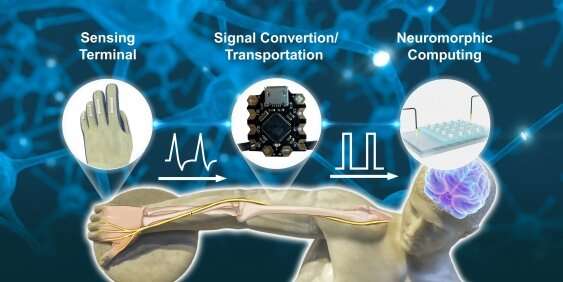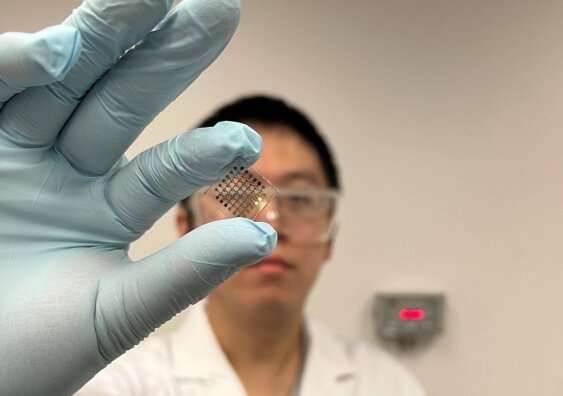This article has been reviewed according to Science X's editorial process and policies. Editors have highlighted the following attributes while ensuring the content's credibility:
fact-checked
peer-reviewed publication
trusted source
proofread
Developing technology to mimic the function of skin

Scientists at UNSW Sydney have combined artificial synapses with advanced sensors to mimic the properties of human skin, in new research published in Advanced Functional Materials.
Inspired by the human skin, researchers from the School of Material Sciences & Engineering have developed an electronic device which is able to detect mechanical stimuli for information processing, including gesture and handwriting recognition, with ultra-low power consumption.
In biological nerve systems, sensory organs such as skin can detect stimuli and the generated signals can then be transmitted to the human brain via neurons and synapses for processing and eventually, response.
"People can feel pressure, pain, and interact with the surrounding environment through physical contact via the skin," says Professor Dewei Chu, lead author of the study.
"Our system is proposed to mimic the functionality of the human skin, and several skin-like capabilities have been demonstrated."
With further development, this technology could find applications in a range of fields, including elderly care, extreme sports monitoring, and motion capture.
What is E-skin?
Artificial skins are emerging as a transformative sensing technology to meet the rising demands for real-time monitoring of vitals including blood pressure, temperature, and oxygen levels.
As well as uses in health care settings, E-skins could be used to measure the health status of athletes and people working in hazardous environments.
Recently, stretchable strain sensors have been developed to mimic human skin perception by measuring pressure, tension and weight. The existing sensors can detect and convert external stimuli into electrical signals.
"The problem is that most of these sensors don't have the capability to actually process the signals. To do that it would require another processor which would consume a lot of electric power," says UNSW's Dr. Tao Wan, corresponding author on the paper. "So without a processing functionality, these sensors alone are unable to match human skin's sensory function."

Combining sensors with neuromorphic computing devices
To overcome the limitations with current artificial perceptual systems, the team of researchers turned to the human nervous system for inspiration.
Biological synapses are the bridges connecting neurons around the body—they play a key role in brain memory and learning functions. For Prof. Chu and Dr. Shuhua Peng, from the School of Mechanical and Manufacturing Engineering, these biological systems have been fundamental to developing this latest technology.
"The electric current that powers our device corresponds to the strength of the connection between two neurons. And we applied electric stimuli to control the device conductance to emulate human synaptic behaviors," says Prof. Chu. Using artificial neurons in this way is known as a neuromorphic computing.
The complete system consists of the neuromorphic computing device, combined with highly responsive sensors developed by Dr. Peng.
"The sensors are highly sensitive to any applied strain, and different electrical signals will be generated under various deformation," says Prof. Chu. "If you combine our device with the sensors, it consumes much less power, and is smarter and more energy efficient."
The sensors can detect subtle human motion, and monitor physiological signals, including wrist pulse, respiration and vocal cord vibration, and the neuromorphic computing device can detect the stimuli and interpret the sensing information for gesture recognition.
Promising potential and future work
"This work offers new insights in designing artificial synapses and sensors to process and recognize information for neuromorphic computing and artificial intelligence applications," says Prof. Chu.
"For example, it offers promising potential for the advancement of smart wearable technology that could detect body movement, or could be applied to soft robotics and prosthetics."
While this research marks an important advancement in the development of E-skins, there is still work to be done before we begin to see it used in our everyday lives.
While the perceptual system can recognize simple gestures with a high success rate, such as a thumbs up, or a fist, some complex gestures are difficult to identify, requiring further modification of materials and device structures.
"Now we want to focus on improving the sensing and information processing capabilities of the system, and further expand the application in tactile and visual perception," says Prof. Chu.
More information: Fandi Chen et al, Bio‐Inspired Artificial Perceptual Devices for Neuromorphic Computing and Gesture Recognition, Advanced Functional Materials (2023). DOI: 10.1002/adfm.202300266




















